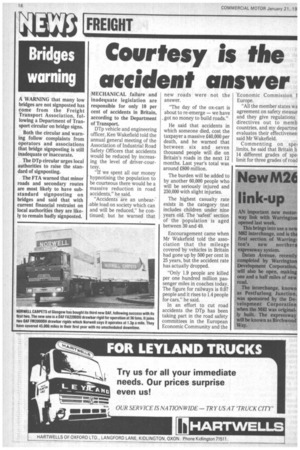Courtesy is the accident answer
Page 18

If you've noticed an error in this article please click here to report it so we can fix it.
A WARNING that many low bridges are not signposted has come from the Freight Transport Association, following a Department of Transport circular on bridge signs.
Both the circular and warning follow complaints from operators and associations that bridge signposting is still inadequate or inaccurate.
The DTp circular urges local authorities to raise the standard of signposting.
The FTA warned that minor roads and secondary routes are most likely to have substandard signposting on bridges and said that with current financial restraint on local authorities they are likely to remain badly signposted. MECHANICAL failure and inadequate legislation are responsible for only 10 per cent of accidents in Britain, according to the Department of Transport.
DTp vehicle and engineering officer, Ken Wakefield told the annual general meeting of the Association of Industrial Road Safety Officers that accidents would be reduced by increasing the level of driver-courtesy.
"If we spent all our money • hypnotising the population to be courteous there would be a massive reduction in road accidents," he said.
"Accidents are an unbear-' .able load on society which can and will be reduced," he continued; but he warned that new roads were not the answer.
"The day of the ox-cart is about to re-emerge — we have got no money to build roads."
He said that accidents in which someone died, cost the taxpayer a massive E40,000 per death, and he warned that between six and seven thousand people will die on Britain's roads in the next 12 months. Last year's total was around £800 million.
The burden will be added to by another 60,000 people who will be seriously injured and 250,000 with slight injuries.
The highest casualty rate exists in the category tnat includes children under nine years old. The 'safest' section of the population is aged between 30 and 49.
Encouragement came when Mr Wakefield told the association that the mileage covered by vehicles in Britain had gone up by 500 per cent in 25 years, but the accident rate has actually dropped.
"Only 1.9 people are killed per one hundred million passenger miles in coaches today. The figure for railways is 0.07 people and it rises to 1.4 people for cars," he said.
In an effort to cut road accidents the DTp has been taking part in the road safety committees in the European Economic Community and the 'Economic Commission f Europe.
"All the member states wa agreement on safety measur • and they give regulations directives out to memb countries, and my departme evaluates their effectivenes! said Mr Wakefield.
Commenting on sp.e■ limits, he said that Britain h 14 different grades of spei limit for three grades of road


























































































































